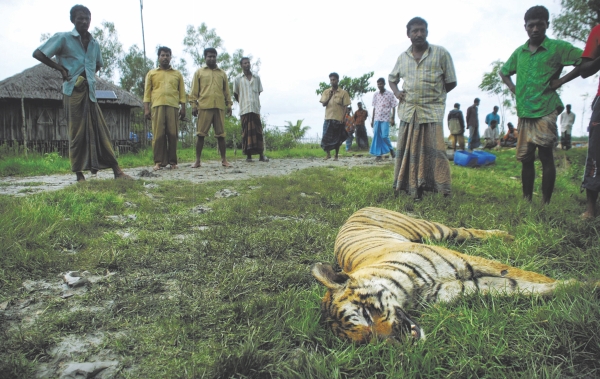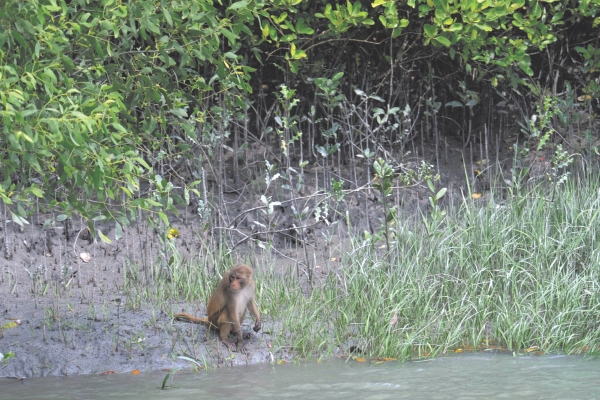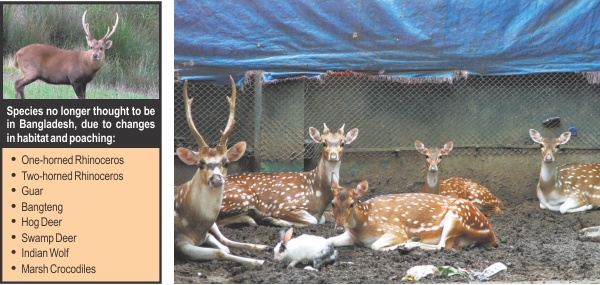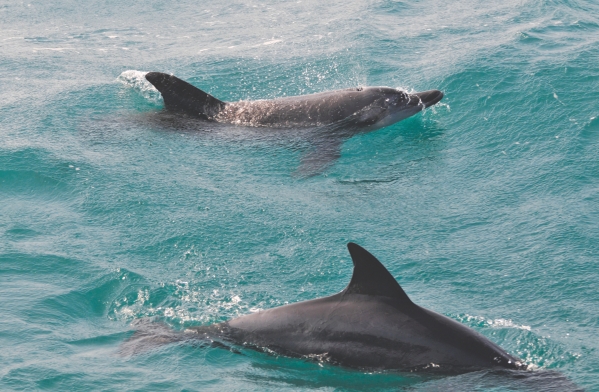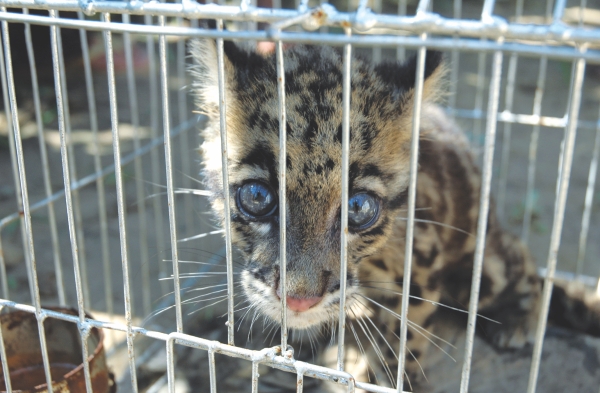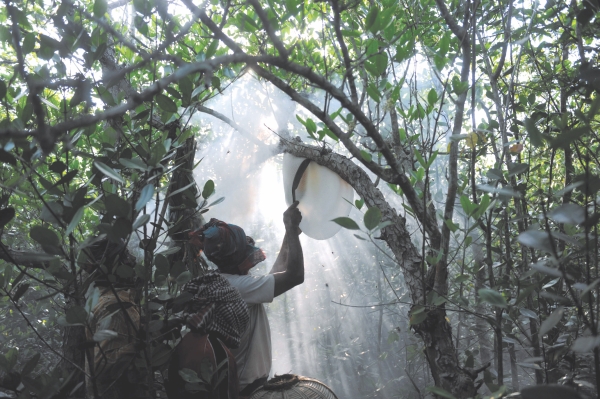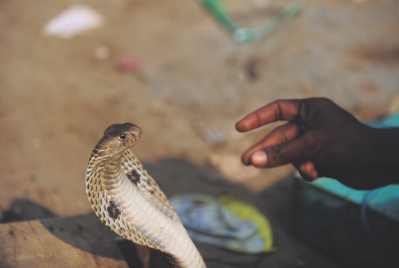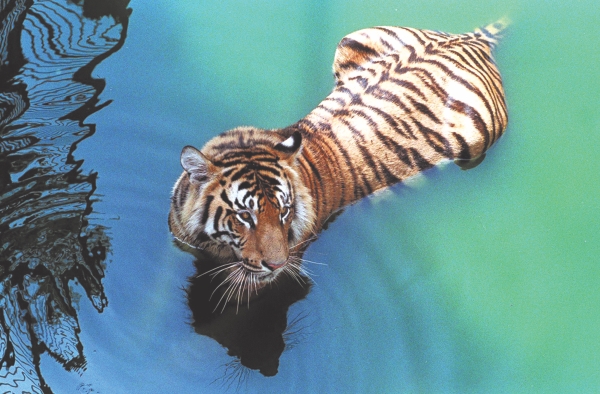| Home - Back Issues - The Team - Contact Us |
 |
| Volume 11 |Issue 27| July 07, 2012 | |
|
|
Cover Story
Lost Wards of the State International trade in wildlife, estimated to be worth billions of US dollars worldwide, is big business. Despite being protected by international agreements and national laws, endangered species are poached from, trafficked through and sold in Bangladesh. RAB's recent success of recapturing three tiger cubs brought this illegal trade back into the public eye but the reality of the business remains ugly and, for the time being, unstopped. Soraya Auer and Anika Hossain If a majestic endangered animal falls prey to a poacher's trap in a forest but no one is around to hear it, can we be sure it happened? It is no secret that the poaching and killing of wildlife takes place in Bangladesh's wilderness. What remains a mystery, however, is how many wild animals are successfully poached and trafficked in and out of the country compared to the numbers that are stopped. According to wildlife experts and government officials, Bangladesh is home to a plethora of unique wildlife from the large Royal Bengal Tiger to the slight Tokay gecko (tokhok). The Forest department, a division of the Environment and Forests Ministry, is custodian to more than 800 species of wildlife across 150,000sq km, including three critically endangered, 12 endangered, 16 vulnerable and four near-threatened mammals. The wildlife most commonly poached in Bangladesh are tigers, deer, turtles, birds, pythons and other snakes, marsh crocodiles, gharials, leopards, including the rare Clouded Leopard, and elephants.
The enormous task of ensuring Bangladesh's wildlife is not disturbed is a challenge, admits Aparoop Chowdhury, Additional Secretary of the Environment and Forests Ministry. “We have people who are in charge of the surveillance and safety of wildlife in the forest areas but the number of people is not sufficient to do this job as well as it should be done,” explains Chowdhury. “The guns and weapons they carry are from the British era and, naturally, do not work well. Communication with them is also difficult, since they have no new technology at their disposal and are practically in the middle of nowhere.” Chowdhury, however, goes on to say that where the ministry has lacked on the ground, it has made up legislatively. “We have amended the Wild Life Conservation Act in 2010,” the Additional Secretary informs. “If anyone kills a wild animal for trade or any other reason apart from self-defence, they have to pay a large fine to the government and depending on the case, can be imprisoned for a long period of time.” He adds, “There are also severe punishments issued for trafficking wild animals.” “Most of the time, the motivation of killing the animal is financial,” says Commander M Sohail, Director of the RAB media wing. “If they kill a tiger or a crocodile it will be for the skin, elephants are killed for their ivory tusks, and deer are killed for their skin as well as their meat.”
While tough legal measures are certainly necessary to curb the illicit trade in wildlife, punishing a culprit quickly and harshly often overlooks motives and people's understanding of their actions. Rubaiyat Mowgli Mansur, a dolphin researcher and wildlife photographer, believes some coastal poor people are just unaware of what is right, legal or even ethical. “This winter, we found for the first time an alarming number of people in coastal villages not realising that this thing that was cut up in the markets, that looks like red meat, was endangered dolphin,” says Mansur, referring to the Ganges River Dolphin. “This was really shocking for us but we believe this is a relatively recent development. People are not hunting the dolphins to sell in the market, but rather dolphins get entangled in the fishing nets and then they don't throw them away but sell them to somebody and that somebody cuts it up and takes it to the market.” The researcher explains that this discovery is not as bad as in the Jamuna River where there is targeted killing of dolphins so fishermen can extract dolphin oil to use for a special fishing technique. Mansur argues it is more important to influence the village people by raising awareness about the endangered mammals than rushing the police over to arrest them. “It's really worrying but also inevitable as people are becoming poorer and this is meat, so they are going to go for alternative meat sources,” he explains. However, not everyone can claim ignorance of wrongdoing. There is an indefinite number of poachers and traffickers across the country who are more than aware of the illegality of their actions. Tanvirul Arefin Lincoln, who owns a tour company, was approached by a new acquaintance about capturing geckos. “Because of the nature of my work I have to visit places like Bandarban, Srimongol, and Lawachara National Park and this man said he knew people who would pay 20 to 40 lakhs if I could provide 500 grams of geckos from these areas,” recalls Lincoln. A few days later, he received an MMS from Malaysia with a photograph of the gecko they were looking for. “I was extremely concerned about this matter and consulted a few members of the nature conservation group and since the matter involves the trafficking of wild animals, we knew we should definitely report it.” Despite reporting the incident to the Srimongol police department, word spread and many people took it upon themselves to find geckos to sell to those buyers.
“I heard from people in the area that some had managed to capture four or five geckos but they died in captivity before they could be sold. We found it very strange that people would be willing to pay so much for these geckos and stranger still that no one seemed to have sold any to these foreign buyers directly,” explains Lincoln. After investigating, Lincoln now suspects the request for geckos was an elaborate scam. “A member of the group would spread the rumour about some foreigners wanting to buy geckos for 40 lakhs or more. The next day or soon after, another member of the same group would show up with a few geckos and claim he had heard that people were willing to buy them for a lot of money. People interested in collecting 500 grams of geckos would want to purchase these so they could make a profit.” Lincoln concludes, “The scam artists make easy money and the people who were scammed would keep searching for the buyers who wanted to buy them originally for a larger amount and in the mean time, the geckos would die. They are endangered as it is, so it is a shame that we are losing them this way.” The search for geckos may well have been a scam but the truth is, animal parts, such as tiger and deer body parts, are some of the most sought after illegal goods abroad. “You can't just catch and transport an adult tiger while it's alive,” explains Reaj Morshed, Programme Officer at Wildlife Trust of Bangladesh (WTB). “Normally they are killed, and then their body parts are separated and transported somewhere. Deer meat is for consumption and also deer antlers have different purposes. They are not normally poached to become pets.” Morshed believes Bangladesh does not create a demand but rather supplies an international demand and acts like a transit lounge for traffickers who have benefited from the country's weak law enforcement in past decades. He informs, “There are tiger farms in China where they are breeding tigers and then they are using the body parts for different medicinal purposes, but raising tigers in a farm is expensive whereas poaching them from the wild is free so that's why there may be a demand for tiger body parts.” Morshed also explains some of the poachers' less than humane methods of killing wildlife. He says, “They use traps, guns and poison. They dilute poison with water and put it into something plastic, often a condom, and then put the condom of poisonous water into bait and put it in the forest for the tiger to eat and be poisoned.” Over the years, stories of rescued wildlife, such as the 480 rare Starred Tortoises seized by Dhaka airport customs officials in 2010, have captured the public's interest. Last month, the nation's heart strings were plucked not once but three times by three two-month-old tiger cubs, rescued by RAB from a smuggler's house in Shyamoli, Dhaka.
“The tiger cubs are a unique case because normally you don't find the animals alive,” remarks Morshed of WTB. The three siblings, while not in great shape when rescued, were indeed alive and have improved under the care of Forest department staff and visiting wildlife experts from Thailand. Commander M Sohail says, “One of the three tiger cubs rescued recently was supposed to be shipped to Malaysia but that attempt failed so they decided to sell all three locally.” A tip off from a source then led RAB to the animal trafficker's home where the three cubs were seized and two people were arrested. Two of the traffickers, who escaped the raid, remain at large. While the future of the tiger cubs was on everyone's mind, questions arose last week as to whether the mother they left behind in the Sundarbans was still alive. A local newspaper reported Isa Morol, 30, believed to be part of an illegal trafficking gang, was arrested for poaching the cubs after locals claimed they'd seen him kill, skin and debone the mother. Sub-inspector Shahidul Islam Shahid from Satkhira, who is in charge of the case, told the Star, “He admitted that he found the tigress feeding her cubs, and they had a poisonous injection of sorts with them which he administered on her with a stick and when she lost consciousness he removed her from the cubs and took them. The locals claim that he killed the mother.” He adds, “We don't know how much of this is true.” It may never be certain whether the tigress was left alive or dead, but as WTB's Reaj Morshed explains, it is perhaps too late to reunite the cubs, who have been living in Dhaka Botanical Garden, with their mother. “The cubs have been separated from their mother for one month, so it is impossible to return them into the wild right now,” Morshed explains. “Their mother is probably still lactating but may not recognise her cubs and more probably, has moved on. If we send the cubs back now, they'd probably be eaten by another animal but there are ways to raise these cubs so that they are reintroduced into the wild in the future.” He adds, however, “Right now they are being fed but if they were in the wild, they'd be trained by their mother how to survive and hunt. Learning from their mother and learning while in a safari park is just not the same at all.” The Fine Print Dr Asif Nazrul, Professor of Law at Dhaka University, explains how Bangladesh is one of 175 countries with international obligations under the Convention on Biological Diversity, and the Convention of International Trade in Endangered Species (CITES). There is a list of endangered species specified by CITES. Bangladesh has an international obligation to stop poaching and trading of animals on this list. It cannot allow any person or any institution, governmental or non-governmental, to conduct a business involving endangered wild animals on the list.
“Under domestic laws, Bangladesh has three Acts, under which the government is obligated to stop poaching. One of these is the Environmental Conservation Act, which states that some areas of Bangladesh have been declared 'ecologically critical'. The act states specifically, the names of the species that cannot be used in any sort of trade from each of these areas. For example, St Martins Island is on this list, so one cannot smuggle turtles, shells or any sea animals out of this area,” informs the Law professor. Another important piece of legislation is The Wild Life Preservation Act 1974, as it contains a list of areas where the hunting and capturing of animals for any purpose are completely banned. The third law is the Cruelty to Animals Act which, among other things, dictates the conditions under which animals should be kept while in pet shops. Commander M Sohail is of the belief that, “the law deals with Bangladeshi animals being illegally captured and trafficked abroad, but if foreign birds are imported, this is not covered by the current law. Of course there are certain regulations that have to be followed when importing anything from abroad, and in most cases in Katabon [well-known pet market on Dhaka University property], they import foreign animals legally. It is the wild animals of Bangladesh that are banned from this trade.” However, Dr Nazrul points out how traders can get around the rules and bring in illegal endangered species. “Sometimes, tradesmen obtain a license to import one animal but will bring a completely different one into the country. This should be strictly monitored.” He adds, “The international convention that we are a part of [CITES] prohibits the import of endangered wild animals into the country and Bangladesh is currently violating international agreements and obligations by not restricting the import of these animals.”
Professor of Zoology at Jahangirnagar University, Dr Moniruzzaman, opines, “There are laws in place but they are useless without proper enforcement. I think the solution to this problem is raising mass awareness. In a country like Bangladesh, creating laws is not enough to stop these crimes. People need to be aware of the implications of trafficking and poaching endangered animals. They need to be made aware of the fact that these animals are endangered.” He suggests teaching children at a young age in school about the effects of disrupting the ecosystem and making documentaries on the topic. Wildlife Trust of Bangladesh is in the process of developing a wildlife crime monitoring strategy to help increase the Forest department's capacity to deal with wildlife crime in the future, as the latter struggles to cover the large landscapes that are home to hundreds of species. However, when that work will transform from policy into practice is the big question. The laws may not have been properly enforced until now, but many people who entertain the idea of owning an exotic animal think the law only applies to poachers and traffickers, not to themselves. The country's population is already fast encroaching upon our wildlife's habitat, making it all the more important to protect. The majestic endangered animal that fell prey to the poacher does not belong in a cage, be it of metal or cement walls – not that all of them are even lucky enough to be wanted alive.
|
||||
Copyright
(R) thedailystar.net 2012 |
